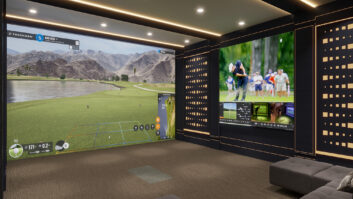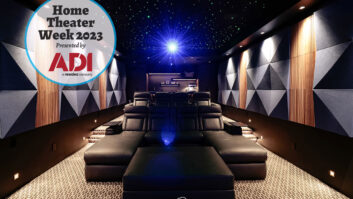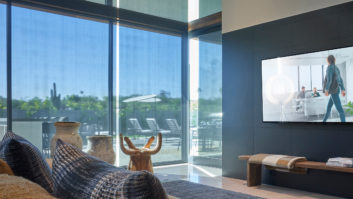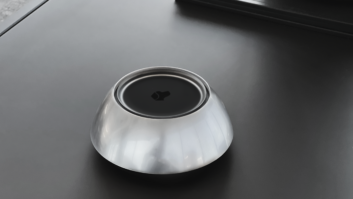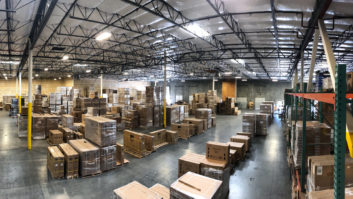
ELAN Home Systems has expanded its line to include 4-, 6.5-, 7- and 10-inch models. Pictured is the Via100EM.
To match wits with the iPhone and iTouch interfaces that Apple has unleashed on the consumer marketplace, touchpanel manufacturers in the residential systems world are faced with a challenge. They must balance trendy functionality like Apples pinch maneuvers with what will be practical and sustainable for home integration solutions of the now and in the future.
AMXs CTO, Robert Noble, studies new technological innovations and tries to distill them down to what is truly useful to homeowners. Is the new technology a fad and a cool feature everyone brags about? Noble wondered. Or is it something I can turn into a practical part of a product that makes it easier for someone to interact with our control systems?
Touchpanels as a Standard

RTI’s T4 is a touchpanel designed to be intuitive.In the past, remote controls and in-wall touchpanels/ handhelds were optional amenities and often cost prohibitive for an average home. Now the range of options on the market for touchpanel control has grown considerably, and the wide array of technologysuch as audio, video, lighting, climate control, and securityhas become a standard to the mainstream consumer. Looking forward, more and more consumers will likely come to expect ethernet capability, Web browsing, and active displays with full video on their touchpanels.
With this quick proliferation comes the need for touchpanels to remain user friendly and readily adoptable. The touchpanel is a means to an end, said Pete Baker, RTIs vice president of sales and marketing. The end-user wants to access the technology easily. A touchpanel needs to be intuitive.
In addition to making them simple to operate, the right size needs to be available for each custom client. ELAN Home Systems has expanded its line to include 4-, 6.5-, 7-, and 10-inch models. For ELANs president and chief technical officer, Bob Farinelli, the trend is to have more options of sizes and also price point reductions to accommodate a growing customer base.
Making the Installers Job Easier
For integration firms, programming a touchpanel has always been a costly endeavor in terms of time and labor. Lately, however, manufacturers have responded to the needs of their dealers by introducing touchpanels that require less labor-intensive programming. At RTI, professional integrators are the driving force behind decisions and suggestions on touchpanel programming improvements like this. The integrator plays a major role in designing the programmable controller in the house, said RTIs Baker. In the past, a consumer could get a universal remote control. Now with the complexity of systems and the number of components, the consumer is putting higher value on professional integration and using an appropriate control device.

As a manufacturer, Niles responded to the lack of trained programmers dilemma with a touchpanel, the iRemote TS that was less programming intensive. Concurrent with the increased reliance on the integrator for consumers, is theadded labor required from the integrator to program the typical touchpanel. Unfortunately for the integrator, holding on to a good programmer is not always easy. As a manufacturer, Niles responded to this dilemma with a touchpanel that was less programming intensive.
We introduced IntelliControl ICS two and a half years ago, said Frank Sterns, president of Niles. I would hear about how a programmer just quit, and there were not enough programmers available at installation companies. All these touchpanels at the time required custom programmers. I came back to the office and decided that we had to develop a touchpanel that doesnt require custom programming. Programming for the Niles ICS entails a modular architecture with multiple user interfaces and multiple sources through a card cage.

Audio Design Associates Inc. (ADA), with its TS-5000, was not in the touchscreen business up until last year. Audio Design Associates Inc. (ADA) was not in the touchscreen business up until last year. For them it was important to introduce a touchscreen solution that works as easily as their keypads for the end-user and for the programmer at the installation company. In the summer of 2007, ADA started shipping the TS5000 touchscreen. Its program-less, said Richard D. Stoerger, vice president and COO of ADA. We integrate with AMX, Crestron, Lifeware, Colorado VNet, Universal Remote Control, Core Access, Vantage.
The TS 5000 has a few design parameters. What Stoerger means by program-less is that the touchscreen itself contains all the graphics and code. All the pages are internal to the touchscreen. It doesnt talk to a controller in the rack like an AMX or Crestron panel. Instead, it plugs in on Cat-5 and uses a PC software application in which you type room names, source names, what the sources are, then uploads this information to keypads. Touchscreens configure the pages, automatically, Stoerger said. The dealer doesnt have to deal with graphics or code or heavy duty custom programmer stuff that is central to more advanced systems.
Convergent Living has observed that the industry, overall, has migrated in the past eight years from brute force integration to a more scalable opportunity for integrators. Dealers want the capability to offer their employees an easier installation but also to garner the higher end opportunities with custom control environments, said Craig Slawson, owner of Convergent Living.
Slawson added that while a customized look and feel and functionality remains for its customers, more complex functionality is going downmarket so that more people can afford it. Convergent marries touchscreens with processors or creates smart screens that are all-in-one solutions for control systems for homes and commercial environments, Slawson said.

Crestron, with its TPS 17-inch touchpanel, has invested heavily in creating advanced development tools like its own SystemBuilder software.
Crestron, which is perhaps the most widely known touchpanel manufacturer, has invested heavily in creating advanced development tools like its own SystemBuilder software. This brings tighter integration between the UI and device control by automatically generating great looking user interfaces which are linked to sophisticated control algorithms, said Fred Bargetzi, vice president of technology at Crestron. In addition, we are releasing unique mechanisms to make network configuration easier and more reliable.
Everything on the IP
In the interest of minimizing programming demands, putting the touchpanel on the network is a step in the right direction. The trend line we encourage is less program-intensive configuration, said ELANs Farinelli. An IP-based system helps. Touchscreens that can access Web content allow for customized information icons: weather, stocks, sports, all those things that high-end control systems provide today with lots of programming and customization. ELAN acquired HomeLogic last year because of its IP-based control system and IP-based touchscreens, Farinelli added.
Isys i/O from Crestron also allows the user to browse the Web through Internet Explorer (IE) to garner real-time information while watching their favorite TV show or sports event. Isys i/O truly makes the experience interactive, said Crestrons Fred Bargetzi. We are continuing to build on this by integrating features like SKYPE (Voice Over IP) control as well as Adobe Flash movies and even application viewers for Microsoft Excel, MS Word, and PowerPoint to deliver a complete multimedia user experience.

Convergent Living, with its Muse touchpanel, marries touchscreens with processors and creates smart screens that are all-in-one solutions for control systems. Convergent marries the server with the touchscreen, making what it calls smartscreens. Today, with the beauty and benefits of the IP backbone, you have the capability of translating the IP signals coming out of a smart screen into direct serial or direct relay control, or direct IR control, said Convergents Slawson. As long as the intelligence is built inside the touchscreen, now you have the capability of managing those systems, including macros and logic-based control needs, in a single screen environment versus having a central processor.
Convergent sees smaller screens in the future, as well. Our processors are getting more sophisticated, Slawson said. On smaller screens you can still have the logic and processing capabilities to manage the entire house.
The Future is OLED
At ELAN, touchscreens are not just an LCD panel but also less expensive organic LED (OLED) display that still provide a touch. This gives us a much less expensive product with similar look and feel to more expensive LCD-based products, Farinelli said. On the very low end, we utilize OLED technology to provide two-way feedback as well as nice graphics in a one- or two-inch display.
On the low end, as the OLED technology matures, the sizes of these displays will increase to four or more inches, according to Farinelli. Theres an opportunity on the low end to provide more interactivity and more feedback at a very low price, as OLED technology continues to mature, he said. When you have the ability to display more information, then you can provide more automation functions and do more things like bigger screens allow you to do.
Let’s Hear from the Integrator
Ken Katz is the general manager for DBC Automation in Edgewater, New Jersey. When it comes to touchpanels, the priority is the obvious: ease of use for the end user. This saves time in training customers and prevents calls later on. This ease of use also makes for the best reference and new business when friends come over and are intrigued by a new touchpanel.
Ease of use is impeded, however, when more systems are added–multi-room audio, lighting, security, shades, or climate control. “As you start to add those systems, it becomes tougher to get a simple user interface,” Katz said.
It is helpful, Katz added, when the touchpanel emulates the device being controlled. “For climate control, it helps if the user interface on the touchpanel looks the same as the thermostat. Or for the security portion of the touchscreen, if it comes up looking like the security keypad, the customer is familiar with that look and it helps,” he said.
In the future, Katz is looking for touchpanels to be more and more simple. Vacation mode, for example, needs to be simpler. “We’re at the point where we’re starting to see end-users look for one setting for all four [system] clients. Instead of putting different systems separately into vacation mode from one touchpanel, the system applies to all the vacation modes of the different controls at once.”
–Joy Zaccaria
Joy Zaccaria is a freelance writer in Brooklyn, New York.
